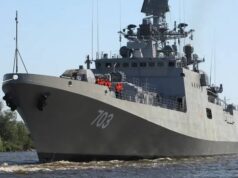Liaoning aircraft carrier Limps into West Pacific for Drills

A ship-borne J-15 fighter jet prepares to land at the flight deck of the aircraft carrier Liaoning
After somehow limping into the Pacific Ocean through the Miyako Strait last week, the Chinese People’s Liberation Army (PLA) Navy’s Liaoning aircraft carrier battle group tried out few routine drills involving fighter jet and helicopter operations in waters east of Japan’s Okinawa, probably in a bid to impress the Japanese, as the area is of strategic importance in safeguarding territorial integrity and national sovereignty of both Japan and China.
The Japan Maritime Self-Defense Force on Sunday spotted the six PLA Navy warships, namely the rust bucket Liaoning aircraft carrier, a modern Type 055 large destroyer, a Type 052D destroyer, two Type 054A frigates and a Type 901 comprehensive supply ship, sailing in waters about 300 kilometers east of Kitadaitojima, Okinawa Prefecture, Japan’s Ministry of Defense Joint Staff said in a press release on Tuesday.
Carrier aircraft including J-15 fighter jets as well as Z-9 and Z-18 helicopters conducted takeoffs and landings during the carrier battle group’s voyage, according to the Japanese press release. However the Japanese Navy was not impressed much.
A photo attached to the press release shows the Liaoning sailing in the ocean, with some J-15 fighter jets and Z-18 helicopters on the flight deck, while another photo caught the moment a J-15 took off from the carrier.
Japan’s Ministry of Defense Joint Staff later on Tuesday published a second press release, saying the Chinese carrier group continued similar activities on Monday.
Japan had immediately dispatched the Izumo, its de facto aircraft carrier, and fighter jets to monitor the Chinese naval activities.
The latest movement of the Liaoning carrier battle group comes after Japan’s Ministry of Defense Joint Staff said in another press release on Friday that the group sailed through the Miyako Strait and entered the Pacific Ocean on Thursday.
The exercise was in the West Pacific outside the Miyako Strait, which is a strategically important gateway the PLA Navy needs to cross in order to reach the West Pacific.
By holding drills there reflects the Chinese aircraft carrier’s desire to impress the Japanese Navy with combat and support capabilities in the high seas. The value of aircraft carriers lies in their ability to operate far away from the homeland for a sustained period. This rust bucket does not have this kind of capability.
West Pacific is also an important potential battlefield if China tries to invade the Republic of Taiwan. forces of the US, AUKUS and Japan will then have no choice but to interfere to protect the Sovereignty of Taiwan a democratic country. Though if this Chinese aircraft carriers takes positions here and tries to attack US and Jap Navy, it will soon be resting at the bottom of the Sea.
Liaoning carries 36 aircraft: 24 Shenyang J-15 fighters, six Changhe Z-18F anti-submarine warfare (ASW) helicopters, four Changhe Z-18J airborne early warning helicopters and two Harbin Z-9C rescue helicopters. The fighter J15 is of doubtful quality and capability. The air wing lacks long-range radar and anti-submarine fixed-wing aircraft, needing support from shore-based aircraft. J-15s have below normal range and armament when operating from the carrier, due to limits imposed by the ski-jump takeoff system. The lack of a carrier onboard delivery aircraft like the United States Navy (USN) Grumman C-2 Greyhound also limits logistics capabilities. Liaoning would need extensive land-based support to oppose a USN carrier strike group or any Indian Navy Strike Group ; however, it would be potent only against the Vietnam People’s Navy and the Philippine Navy.
In July 2018, Lieutenant General Zhang Honghe of the PLAAF stated that China is developing a new carrier-based aircraft that will replace the J-15 due to three crashes and numerous technical problems.
Though the PLA Navy’s second Carrier, the Shandong may be a bit more effective than Liaoning.




